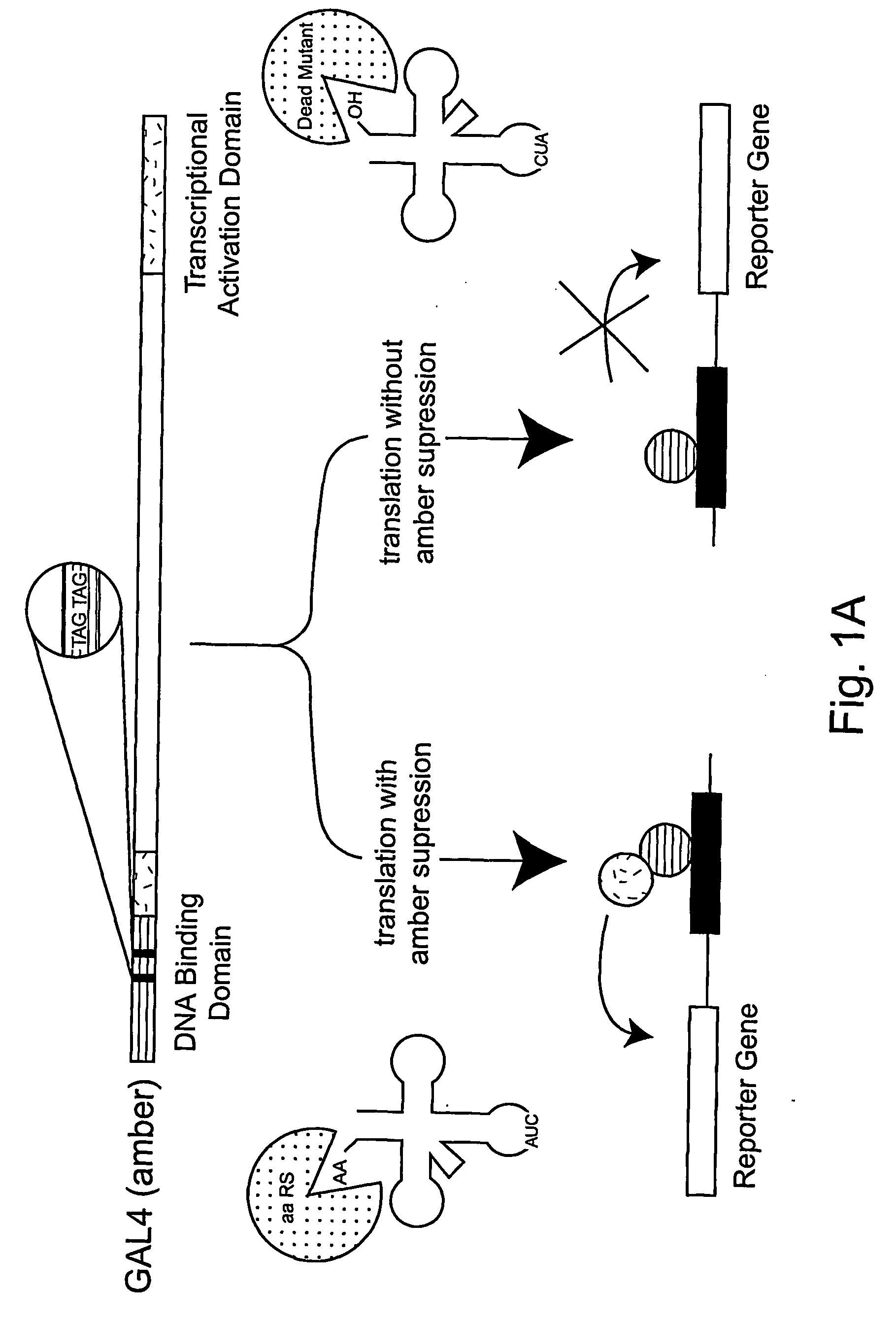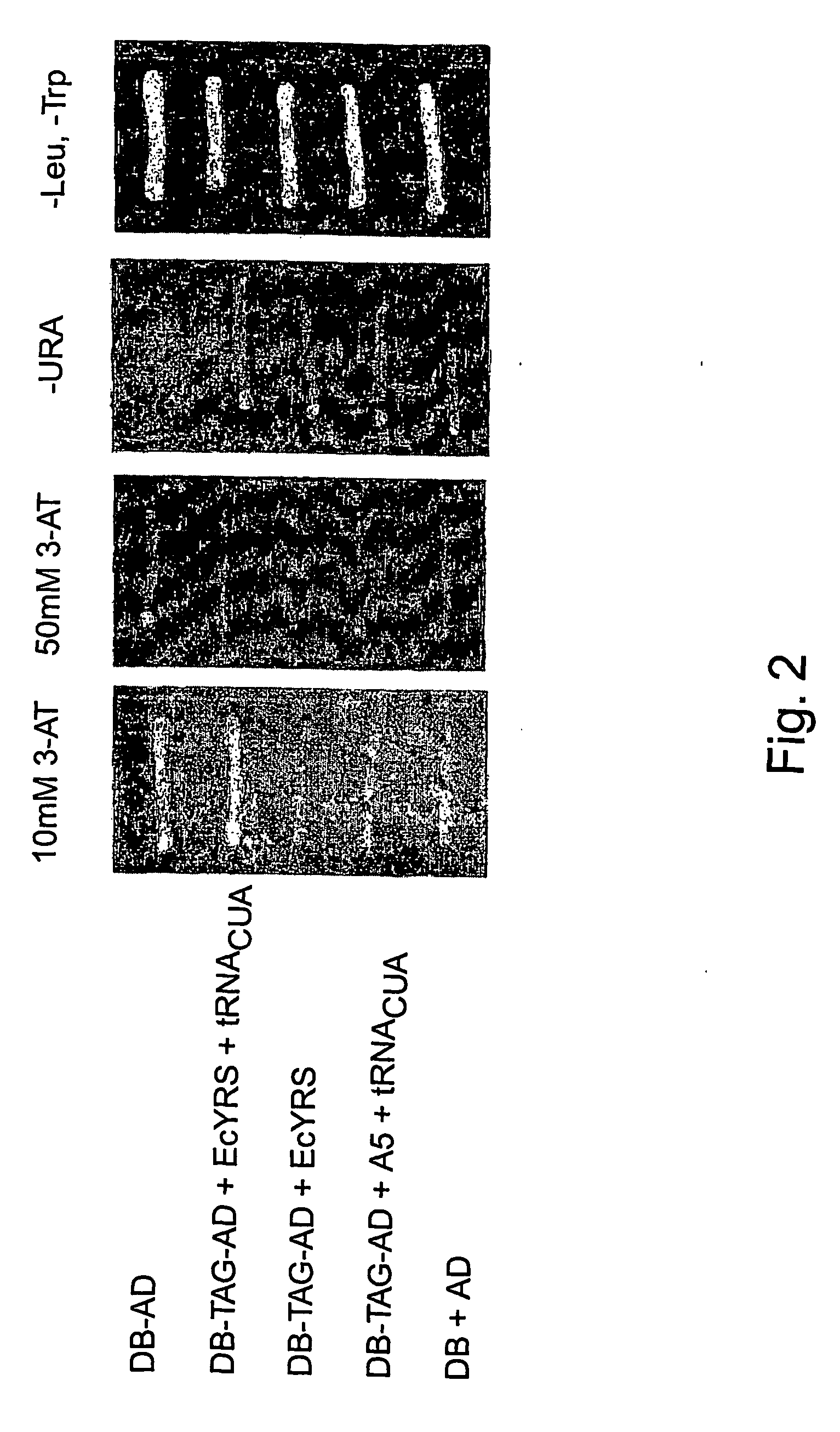Unnatural reactive amino acid genetic code additions
a technology of amino acids and genetic codes, applied in the field of translation biochemistry in eukaryotic cells, can solve the problems of inability to rationally control protein structure and function, difficult to remove the constraints imposed by the genetic code, and limited progress, and achieve high fidelity
- Summary
- Abstract
- Description
- Claims
- Application Information
AI Technical Summary
Benefits of technology
Problems solved by technology
Method used
Image
Examples
example 1
Methods of Producing and Compositions of Aminoacyl-tRNA Synthetases that Incorporate Unnatural Amino Acids in Eukaryotic Cells
[0292] The expansion of the eukaryotic genetic code to include unnatural amino acids with novel physical, chemical or biological properties would provide powerful tools for analyzing and controlling protein function in these cells. Towards this goal, a general approach for the isolation of aminoacyl-tRNA synthetases that incorporate unnatural amino acids with high fidelity into proteins in response to an amber codon in Saccharomyces cerevisiae (S. cerevisiae) is described. The method is based on the activation of GAL4 responsive reporter genes, HIS3, URA3 or LacZ, by suppression of amber codons between the DNA binding domain and transcriptional activation domain of GAL4. The optimzation of a GAL4 reporter for positive selection of active Escherichia coli tyrosyl-tRNA synthetase (EcTyrRS) variants is described. A negative selection of inactive EcTyrRS variant...
example 2
An Expanded Eukaryotic Geneic Code
[0323] A general and rapid route for the addition of unnatural amino acids to the genetic code of Saccharomyces cerevisiae is described. Five amino acids have been incorporated into proteins efficiently, with high fidelity, in response to the nonsense codon TAG. The side chains of these amino acids contain a keto group, which can be uniquely modified in vitro and in vivo with a wide range of chemical probes and reagents; a heavy atom-containing amino acid for structural studies; and photocrosslinkers for cellular studies of protein interactions. This methodology not only removes the constraints imposed by the genetic code on our ability to manipulate protein structure and function in yeast, it provides a gateway to the systematic expansion of the genetic codes of multicellular eukaryotes.
[0324] Although chemists have developed a powerful array of methods and strategies to synthesize and manipulate the structures of small molecules (see, e.g., E. J...
example 3
Adding Amino Acid with Novel Reactivity to the Genetic Code of Eukaryotes
[0338] A site-specific, fast, reliable, and irreversible method of bioconjugation to proteins based on a [3+2] cycloaddition is demonstrated. There is a considerable, need for chemical reactions that modify proteins under physiological conditions in a highly selective fashion. See, e.g., Lemineux, & Bertozzi, (1996) TIBTECH, 16:506-513. Most reactions currently used for the selective modification of proteins involve covalent bond formation between nucleophilic and electrophilic reaction partners, e.g. the reaction of α-haloketones with histidine or cysteine side chains. Selectivity in these cases is determined by the number and accessibility of the nucleophilic residues in the protein. In the case of synthetic or semisynthetic proteins, other more selective reactions can be used such as the reaction of an unnatural keto-amino acid with hydrazides or aminooxy compounds. See, e.g., Cornish, et al., (1996) Am. Ch...
PUM
 Login to View More
Login to View More Abstract
Description
Claims
Application Information
 Login to View More
Login to View More - R&D
- Intellectual Property
- Life Sciences
- Materials
- Tech Scout
- Unparalleled Data Quality
- Higher Quality Content
- 60% Fewer Hallucinations
Browse by: Latest US Patents, China's latest patents, Technical Efficacy Thesaurus, Application Domain, Technology Topic, Popular Technical Reports.
© 2025 PatSnap. All rights reserved.Legal|Privacy policy|Modern Slavery Act Transparency Statement|Sitemap|About US| Contact US: help@patsnap.com



